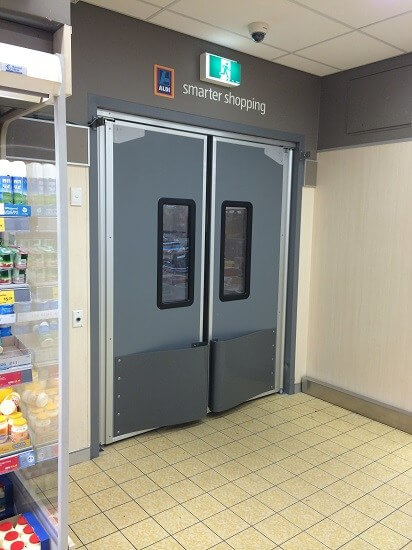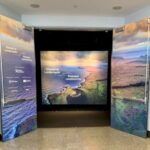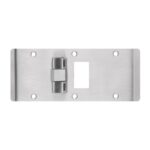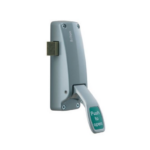 Today’s Quick Question:
Today’s Quick Question:
Are the vision lights in double-acting traffic doors / impact doors required to comply with the accessibility standards?
For most doors – if a vision light or sidelight is present – the bottom of at least one light must be located no more than 43 inches above the floor. This allows all building occupants – including people using wheelchairs – to use the vision lights. There is an exception for doors with vision lights more than 66 inches above the floor because those lights are for light transmission and not for viewing.
The model codes and accessibility standards do not specifically exempt double-acting traffic doors from these requirements, BUT – this type of door is often used in an employee work area. The International Building Code (IBC) includes 14 locations that are exempt from the accessibility standards of the IBC, and employee work areas are included in that list of exemptions (read on). The ADA Standards also include some exceptions related to employee work areas.
The IBC and the ADA Standards define employee work areas the same way:
Employee Work Area. All or any portion of a space used only by employees and used only for work. Corridors, toilet rooms, kitchenettes and break rooms are not employee work areas.
Although the IBC and the ADA Standards exempt some spaces and elements within employee work areas from certain requirements, both require employee work areas to be designed and constructed so that individuals with disabilities can approach, enter and exit the work area. The common interpretation of this requirement is that the entrance and egress doors serving the employee work area would have to comply with the requirements of the codes and standards – including the location of the vision lights.
In addition to an accessible entrance to the employee work area, both the IBC and ADA require common use circulation paths within employee work areas to be accessible routes – with a few exceptions. The exceptions include:
- common use circulation paths within employee work areas with an area of less than 1,000 square feet and defined by permanently installed partitions, counters, casework or furnishings,
- common use circulation paths located within employee work areas, that are an integral component
of equipment, and - common use circulation paths located within exterior employee work areas that are fully exposed to the weather.
An ADA advisory states: Although areas used exclusively by employees for work are not required to be fully accessible, consider designing such areas to include non-required turning spaces, and provide accessible elements whenever possible. Under the ADA, employees with disabilities are entitled to reasonable accommodations in the workplace; accommodations can include alterations to spaces within the facility. Designing employee work areas to be more accessible at the outset will avoid more costly retrofits when current employees become temporarily or permanently disabled, or when new employees with disabilities are hired. Contact the Equal Employment Opportunity Commission (EEOC) at www.eeoc.gov for information about title I of the ADA prohibiting discrimination against people with disabilities in the workplace.
If the traffic/impact door is within an area that is exempt from the accessibility requirements, the vision light would not typically have to be at the location mandated by the accessibility standards. With that said, AHJ interpretations may vary and the ADA advisory recommends incorporating accessible elements wherever possible. Mounting the vision light at the 43-inch location could avoid expensive and time-consuming problems in the field.
Photo: Australian Trellis Door Company
You need to login or register to bookmark/favorite this content.






The typical standard location for a light in a traffic door is usually well above ADA compliance but on the few that I’ve worked on, I had the lights dropped to 43″ AFF. It costs nothing to do it at that stage so why not?
I agree, Bob! The tough part is when the door is installed with the “normal” (higher) light location and the AHJ enforces the requirement. I’m hoping that posts like this help to avoid that.
– Lori
I disagree with Bob’s comment “costs nothing” – one of the major mfg (not to mention names) uses a standard lite kit that is 9″ x 16″ mounted at 60″ aff to the CL of the lite – moving this to 43″ aff makes it so that many can’t actually use this (I’m 5’6″ and this would be an awkward size/location for me). The solution here is to make the lite larger, which does cost money.
Then we come into the realm of who actually bears the cost for this. In theory it should be the owner/architect/contractor, because they need to make their building ADA compliant, but many times in reality, it ends up being the distributor. I might not win the job if I bid an ADA compliant product versus a standard product, but I’ll need to supply a compliant solution.
I do all my double acting doors with vision lights and ADA height, why order anything but
Great! I think that’s the way to go!
– Lori
There is an exception that allows vision lites to be higher than 43″ A.F.F., as long as the lowest part of the lite is located more than 66″A.F.F.
Reference 404.2.11 (Exception), found in the Department of Justice ADA Standards for Accessible Design.
Thanks Greg – I addressed that toward the beginning of the post but I don’t think most impact door lights at the typical height are above the location.
– Lori
Yes. I frequently provide the SCP-8 by Eliason with a 9″ x 30″ lite that the bottom of the lite is @ 43″ AFF. The architect(s) now draw it this way on the plans. It’s amazing what a simple RFI will do.
I really think building owners should evaluated doors that could swing out to hit someone. Not only double acting doors but singles as well. I was walking along a corridor in a restaurant one noon, and an employee came out of the kitchen at breakneck speed, the door not only smashed into my shoulder and arm but the force propelled me like a pin ball across the corridor and into the opposite wall. I think my padding saved me. I am 78 but drink lots of milk for calcium so no broken bones. The reply is meant to be a mixture of serious comment and fun.
I’m glad you’re ok Jerry!
– Lori
Hmm.. I think I have to agree with you for specifying that any installation of an impact door must not hinder the continuous airflow inside a business premise. My neighborhood florist has been considering upgrading his store by adding some additional security features. I’ll ask him to take a look at this matter before taking any further action.